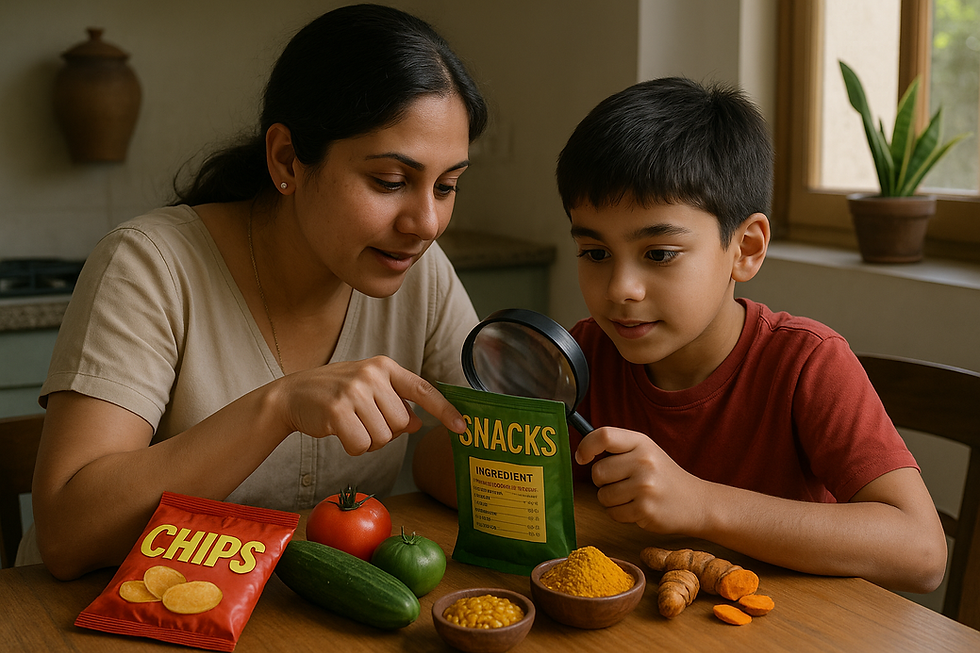Vitamin D for Indian Children: Essential Guide to Deficiency Signs & Importance (Part 1)
- Dr Tejal Risbud Rao

- Apr 28
- 4 min read
Updated: May 8

Worried about your child's vitamin D levels? You're not alone! According to the Indian Academy of Pediatrics (IAP), up to 70-90% of Indian children have insufficient vitamin D, a critical nutrient for growing bones and strong immunity.
This simple guide will help you understand why vitamin D matters, spot the signs of deficiency, and take easy steps to keep your child healthy.
Why Vitamin D Matters for Your Child
Vitamin D helps your child's body absorb calcium for strong bones and teeth. It also boosts immunity and supports overall growth. Without enough of this sunshine vitamin, children can develop weak bones and get sick more often.
As Dr. Tejal Rao, a leading pediatrician in Bangalore, explains, "Vitamin D is not just a vitamin but a hormone that affects virtually every system in a growing child's body."
Did You Know?
Vitamin D deficiency affects children across India differently:
Region | Urban Children (%) | Rural Children (%) |
North India | 84.60% | 58.30% |
South India | 76.30% | 52.10% |
East India | 81.20% | 60.80% |
West India | 88.90% | 55.70% |
Source: Indian Journal of Medical Research, 2023²
Even in our sunny country, children aren't getting enough of this essential nutrient!
How Does the Body Get Vitamin D?
The main way our bodies get vitamin D is through sunlight. When your child's skin is exposed to sunlight (specifically UVB rays), it starts making vitamin D. This vitamin then travels through the body and becomes its active form, which helps absorb calcium and keep bones healthy.
Why Some Kids Don't Get Enough?
Even in a sunny country like India, many children don't get enough vitamin D. In cities, kids often spend more time indoors due to school, screens, or pollution. In hilly areas, the sunlight may not be strong enough, especially in winter. This makes it harder for their bodies to produce enough vitamin D.
To keep your child healthy, try to make sure they get some safe sunlight exposure and include vitamin D-rich foods in their meals. If needed, your doctor may recommend a supplement.
Just a small boost in vitamin D can help your child build stronger bones and stay illness-free. A little sunshine or the right food goes a long way.
7 Signs Your Child May Have Vitamin D Deficiency
Is your child constantly catching colds? Always tired even after a good night's sleep? Or experiencing unexplained aches and pains? These could be warning signs to watch for.
According to the American Academy of Pediatrics, vitamin D deficiency is surprisingly common in Indian children. Look for these specific signs:
Frequent colds and infections - Low vitamin D weakens the immune system
Always tired - Even after proper sleep
Irritability or mood changes - Vitamin D affects brain chemistry
Muscle pain or weakness - Especially in legs and arms
Delayed walking in toddlers - Can affect motor development
Bone or joint pain - Often mistaken for "growing pains"
Dental problems - Poor tooth development or frequent cavities
If you notice several of these symptoms, a simple blood test at your pediatrician's office can check your child's vitamin D levels.
Quick Tip: Trust your parental instincts! If your normally energetic child seems constantly tired or gets sick often, checking vitamin D levels could be worthwhile.
Why Vitamin D Deficiency in Indian Children Is So Common
Even in our sunny country, many children don't get enough vitamin D. According to research published in the Indian Pediatrics journal, the main reasons include:
Limited outdoor time - School, tuition, and indoor activities reduce sun exposure
Urban pollution - Filters out beneficial UVB rays needed for vitamin D production
Darker skin tones Require more sun exposure to produce the same amount of vitamin D
Vegetarian diets - Many vitamin D-rich foods come from animal sources
Indoor lifestyle - More screen time means less sunshine time
Frequently Asked Questions
"How can I tell if my child has vitamin D deficiency without a blood test?"
While a blood test is the most accurate way to check vitamin D levels, watching for multiple signs like frequent illnesses, unexplained tiredness, muscle pain, or slow growth can give you clues. Trust your parental instinct - if your typically energetic child seems constantly tired or irritable, discussing vitamin D with your pediatrician is worthwhile.
"At what age should I start worrying about vitamin D for my child?"
Vitamin D is important from birth. Exclusively breastfed babies are at higher risk since breast milk contains little vitamin D. The Indian Academy of Pediatrics recommends vitamin D drops for breastfed infants. As children grow, their vitamin D needs continue through all developmental stages.
"Can dark-skinned children get enough vitamin D from sunlight?"
Children with darker skin tones need 3-5 times more sun exposure than fair-skinned children to produce the same amount of vitamin D. This is because melanin (the pigment that gives skin its color) naturally blocks some UVB rays. For dark-skinned Indian children, combining good sun exposure with dietary sources is particularly important.
"Can too much vitamin D be harmful?"
Yes. Signs of excess vitamin D include nausea, vomiting, excessive thirst, frequent urination, and confusion. However, vitamin D toxicity typically only occurs with excessive supplement use, not from sun exposure or food. Always follow your doctor's recommended dosage and never give multiple vitamin D products without medical supervision.
What's Coming Next?
In Part 2, we'll cover exactly how much vitamin D your child needs based on their age, the best food sources available in India, and simple ways to ensure your child gets enough of this essential nutrient.
Remember - spotting vitamin D deficiency early and taking simple steps can make a big difference in your child's health and development.





Comments